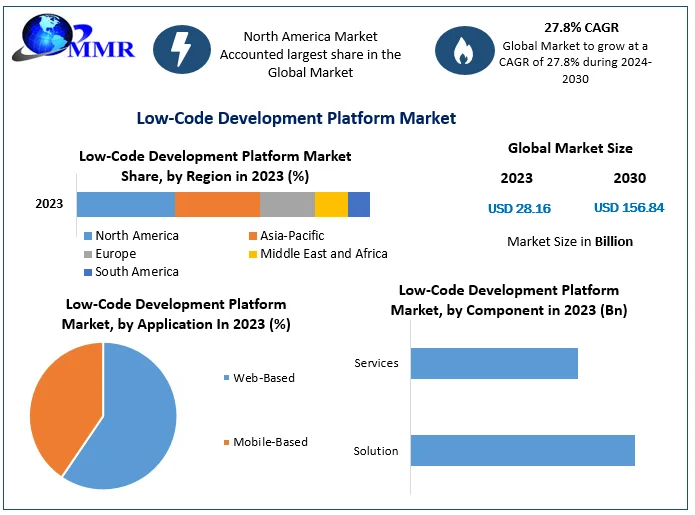Benefits Of Application Development With Low-Code In Terms Of Integration Capabilities
Low-code development of apps has numerous benefits, especially in terms integration. This is essential for creating applications that can effortlessly connect to systems and other services. Here are the key benefits: Pre-built Connectors and APIs:
A Wide Variety of Connectors. Low-code systems usually include a wide range of pre-built connections for the enterprise system that are widely used (e.g. cloud services, databases, CRM). This makes it easier to integrate with systems.
API Integration: A lot of Low-Code platforms come with out-of-box API integration capabilities, which allow developers to effortlessly connect external services as well as data resources.
Simple to Use:
Drag-and-Drop Integration: Integration tasks can often be done using drag-and drop interfaces, making it possible to both developers and non-developers to design complex integrations without writing extensive code.
Visual Workflow Builders : Tools to create workflows and data flows that visually represent help comprehend and setup integrations in a much more simple way.
Standardized Integration Methods:
SOAP and restful services that support web service common protocols such as REST or SOAP allows integration with a a large variety of platforms and systems.
OData Standards and Other Standards Support for standards, such as OData permits easy access to data as well as its manipulation across multiple platforms and applications.
Real-Time Data Synchronization:
Real-Time Integrations: Lowcode platforms are able to handle data synchronization in real-time between the system and applications to ensure that data is up-to-date and consistent across the organization.
Event-Driven Architecture: Some platforms have support for event-driven architectures, permitting applications to respond to events in real-time. This is vital for interactive and dynamic apps.
Legacy System Integration:
Bridging Old and New Systems Low-code platforms usually include tools for integration with older systems, which allows organizations to upgrade their IT infrastructure without having to completely revamp existing systems.
Data Migration Tools - Built in data-migration tools allow you to transfer data from older systems to applications that use low-code.
Integration of third-party services:
Cloud Services Integration: The seamless integration of cloud services, such as AWS Azure, Google Cloud facilitates the easy deployment and scaling-up of applications.
Business Applications Integration: Low-code platforms can be integrated with different business applications like Salesforce, SAP and Microsoft Dynamics. This facilitates seamless flow between the business tasks.
Simplified Data Management:
Unified Data Models - Some low code platforms offer unifying models of data which make it easier to manage data and integration with other systems.
Data Connectors Data connectors that are pre-configured enable users to access and alter data from many sources.
Security and Compliance
Secure Integrations - Low-code platforms have been designed to ensure that all integrations adhere to security standards and protocols. This ensures the security of information both during its travel and when it is stored.
Compliance Features: These platforms typically have features to ensure that integrations meet regulations (e.g., GDPR, HIPAA), providing assurance for companies that handle sensitive information.
Extensibility:
Low-code platforms enable the use of custom scripts and code to meet more complex integration needs. This flexibility is provided without compromising the ease of use.
Plug-in Ecosystems. A community of extensions and plug-ins will allow you to enhance your integration capabilities, and add new functionalities whenever needed.
The overall low-code platform's integration capabilities make it a powerful instrument to create interconnected applications that are efficient and scalable. These platforms streamline the process of integrating various IT systems, boost the flow of data, and aid businesses adopt existing technologies, while also leveraging new ones. See the top Low-code Platform for application development tips for website tips including mobile app development platforms, application modernization, ms azure sql, rad development, rapid application design, low code platforms, app modernisation, push notifications, rad application development, lowcode no code and more.

Benefits Of Low-Code Application Development In Terms Of Scalability, And Flexible
Low-code application development offers several advantages regarding adaptability and scalability, which are essential for creating applications that are able to grow with business needs and change with the demands of business. Here are a few of the main benefits.
Cloud-Based Platforms: A large number of platforms that are low-code-friendly use cloud computing. They let applications grow quickly and smoothly using the cloud infrastructure. This allows companies to handle increased workloads without having to be concerned about managing servers.
Auto-Scaling: This feature can automatically adjust the resources based on the demands. This guarantees consistent performance at peak times, without any manual intervention.
Flexible Architecture:
Low-code platforms promote modular design where components can independently be designed, tested and scaled. Modularity improves flexibility and it's easier to modify specific elements of an app without having to change the whole system.
Microservices Architecture: The Microservices architecture allows the creation of applications by creating a loosely coupled collection of services. This improves the flexibility and scalability.
Customizable Solution:
Extensibility Low-code platforms usually permit custom programming and scripting. Developers can enhance the capabilities of their applications beyond what comes out of the box. This allows the satisfaction of specific business requirements without limits.
Third-Party Integrations: The capacity of companies to integrate APIs and third-party apps in addition to adding new features to their application when required, expands the capabilities of the application.
Agile Development and Deployment
Continuous Deployment and Delivery Low code platforms support agile methodologies, which allow continuous deployment and integration (CI/CD). This allows rapid deployment of features and updates. The applications can grow rapidly as a result of market trends and feedback from users.
Iterative Development: Thanks to the iterative nature, low-code applications can scale and evolve incrementally. This helps reduce the potential risk of major changes and permits greater control over expansion.
Resource Optimization
Low-code platforms offer tools to analyze and monitor the performance of applications that help optimize resource usage. They ensure that resources are utilized efficiently and scaled up or back down depending on actual requirements.
Load-balancing: Features that distribute workloads equally across servers enhance the ability of an application to handle massive traffic and guarantee consistent performance.
Global Reach
Multi-Region deployment: Low-code applications are often able to support deployment across different geographical regions. This allows companies to offer low-latency service to users across the globe. This is essential, especially when it comes to applications that have global users.
Localization Support: Built-in localization support lets applications be modified to accommodate different local languages and requirements. This improves their flexibility on diverse markets.
Maintenance and updates
Simple Maintenance: The aesthetic and modular design of low-code software simplify maintenance tasks making it possible for bugs and updates to be completed quickly and without lengthy downtime.
Version Control Systems for Controlling Versions can assist you in managing updates, rollbacks and changes. They can make sure that they are released without risk and the previous version can be restored when required.
Cost Efficiency:
Low-code platforms can cut development costs because they eliminate the requirement for extensive code. They also make it possible to expand applications without significant increase in effort or expense.
Pay-as-you-go models Many low-code platforms have flexible pricing options for their services, including the pay-as-you go model, which aligns costs to actual usage and growth. This gives financial flexibility.
The majority of low-code app developers provide a lot of flexibility and scalability which allows businesses to quickly build robust and flexible apps. These platforms allow rapid changes to meet changing demands and efficient utilization of resources and continuous enhancement. Applications can expand and change with the business. Follow the best Legacy application modernization with Low-code for website info including develop web app, push alerts, app development platform, app modernization, azure sql, app modernisation, app development platform, paas service, application modernization, rapid action development and more.

Advantages Of Developing Applications Using Low-Code With Respect To Limitations And The Possibility Of Customizing
Low-code design for applications is a balanced, flexible approach that overcomes the limitations of the system and allows for modification. These are the main advantages: Handling limitations
Beating Complexity Barriers
Simple Development : Low-code platform simplifies development by providing components and templates that are pre-built. This allows for faster development and deployment.
A lot of platforms offer guided workflows, which help developers navigate through complicated processes. They reduce the chance of errors and ensure uniformity.
Scalability Solutions
Built-in Scalability: Low-code systems often include features that support scalable architecture, allowing applications to handle increased loads without significant redevelopment.
Performance Monitoring: The tools that track and optimize performance can help ensure that applications are efficient regardless of the fact that they are growing.
Security and compliance:
Security features integrated into Low-code platform come with built-in measures of security such as encryption. Access control that is based on roles and automated compliance check, addressing the most common security issues.
Platforms are constantly updating their security protocols and ensure compliance with regulatory requirements. This helps to keep the applications secure from threats that are constantly evolving.
Options for Customization:
Extensibility:
Custom Code Integration: Low-code platform often allows the integration of customized codes (e.g. JavaScript, Python) that allows developers to expand the functionality beyond what the standard offers.
Moduls and plugins that are custom-designed: Developers may create custom plug-ins or modules that offer specific functions specifically tailored to the needs of a business.
APIs and Integration
API Support: The extensive API support permits seamless integration of other systems and services. This facilitates extensive customization and connectivity.
Third Party Services: Low-code platforms often offer pre-built connectors for popular third-party services, making it simpler to connect and modify applications.
Flexible UI/UX:
User-friendly interfaces with customizable options: Users can create and customize their own user interfaces which will provide an experience that is more customized.
Responsive Design The built-in capabilities of responsive design make sure that applications are able to be tailored to various screen sizes and devices.
Making Business Logic more flexible is simple:
Visual Workflow Builders Visual tools for creating and customizing workflows as well as business logic enable developers to create complex, tailored processes without extensive coding.
Conditional Logic & Scripting : Platforms support conditional logic, as well as customized scripting to comply with particular business rules.
Data Management
Custom Data Models: Developers are able to design a custom data model to satisfy specific requirements of an application, and ensure that data handling is in line with the requirements of business.
Advanced Data Processing: Integration with advanced tools and capabilities for data processing allows for customizing how data is analyzed and used within the application.
Balanced Limitations and Customization
Frameworks and Standards:
Low-code platforms encourage the use of industry-standards and best practices, resulting in top-quality software that is flexible and secure.
Governance Frameworks Governance Frameworks: Integrated governance frameworks make sure that customizations don't compromise the integrity, conformity, or the security of an application.
Iterative Development and Feedback:
Rapid Prototyping : Developers can quickly prototype and test customizations using the feedback of users, enhancing the application based on their needs.
Continuous Improvement: Platforms using low-code support continuous improvements, allowing customization and enhancement when the requirements of business change.
Empowering Users:
Empowering Citizen-Developers: Low-code platforms increase the number of contributors capable of enhancing and modifying applications through permitting them to create custom intuitive user interfaces.
Support and training: A lot of platforms include extensive training resources and support services that assist users in making modifications that are effective without compromising an application's performance or stability.
Low-code development is an effective framework that permits a lot of customization while addressing any issues. This allows businesses can build and maintain applications that are functional and customized to meet their particular requirements, while keeping high standards of quality, security and the ability to scale.

Comments on “New Facts For Selecting Legacy application modernization with Low-code”